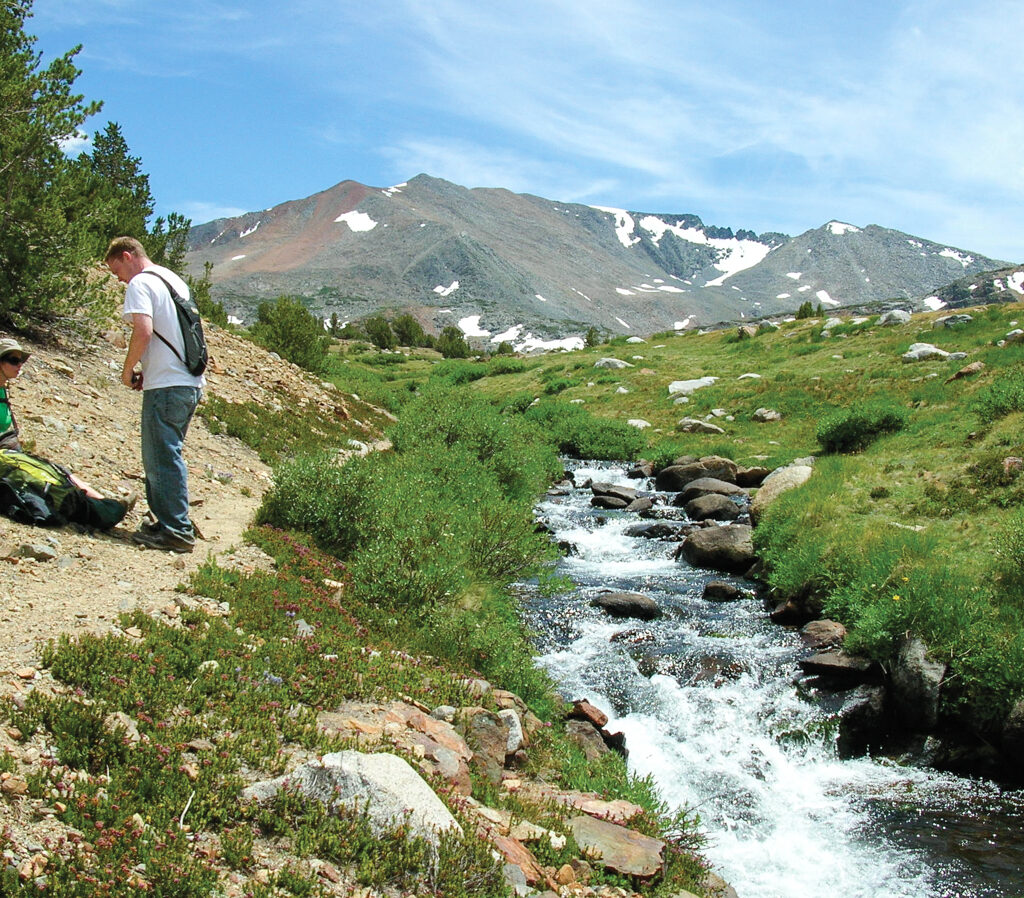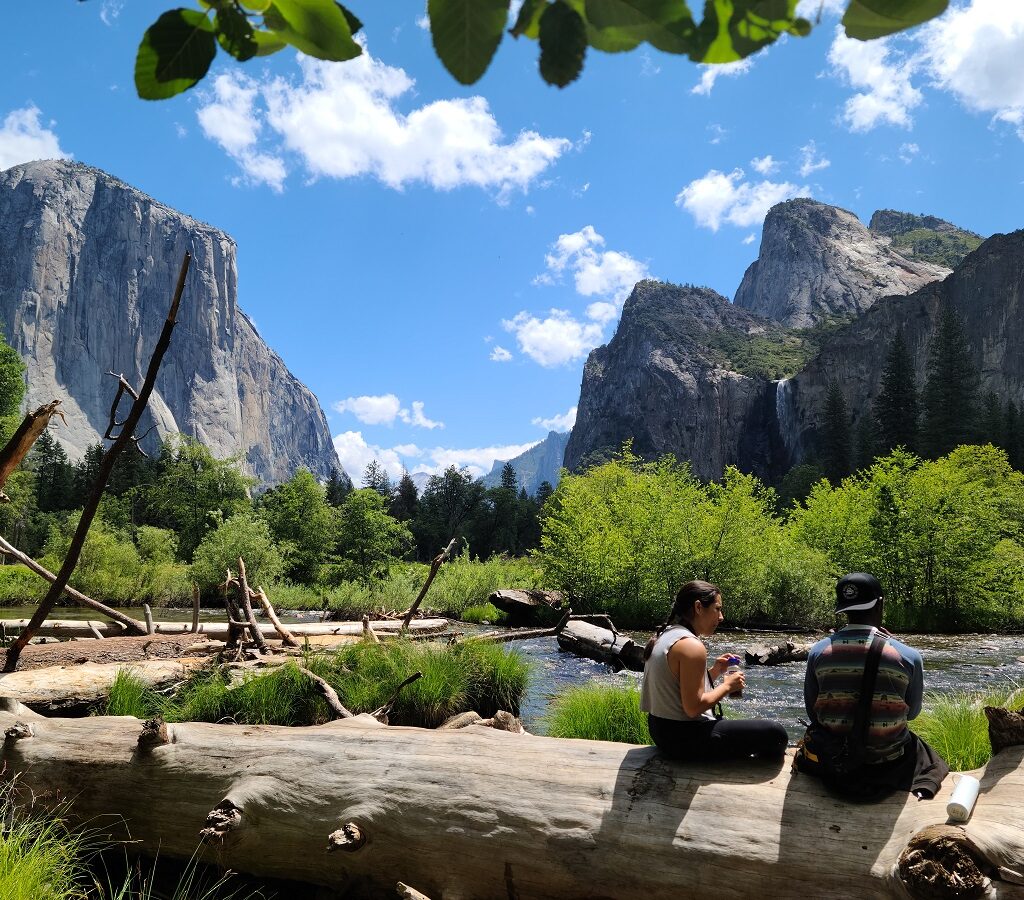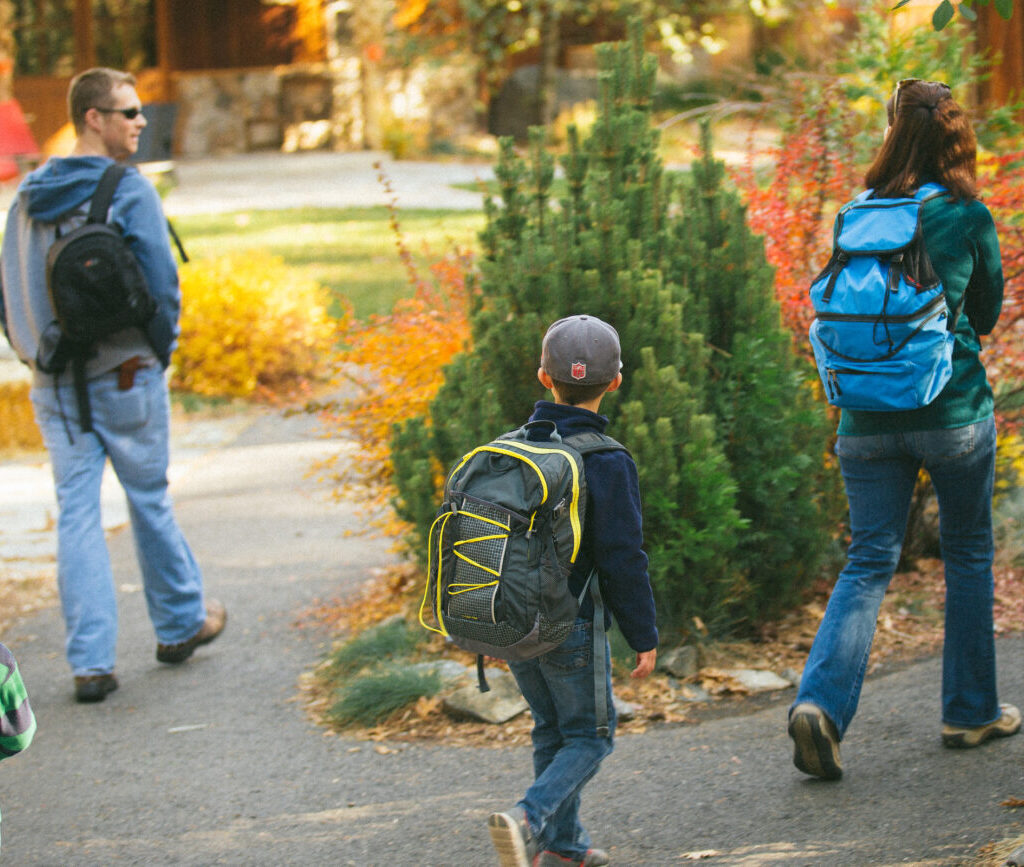Spring has sprung, and Yosemite’s prime hiking season is quickly approaching. Every year around April 15th, the plowing crews at Yosemite begin removing the snow and ice from Tioga Road and Glacier Point Road. This time of year signals that the snow from the previous winter is melting, and Yosemite’s waterfalls will soon flow strong.
As you begin planning for your upcoming Yosemite vacation, allow us to help you prepare. Hiking will surely be one item on your busy itinerary. Whether you plan on hiking one of the shorter, easier trails like the half-mile Lower Yosemite Falls Trail or this is the year you plan to hike all seven and a half miles to the top of Yosemite Falls, many of your hiking essentials will be the same. Here is our comprehensive list of what to bring on a day hike in Yosemite.
Clothing and Footwear For Your Yosemite Day Hike
1| Waterproof Hiking Shoes
Even if you don’t plan on hiking across any streams or rivers, waterproof hiking shoes are a great comfort in Yosemite. As we have mentioned, springtime signals the melting of snow and this causes many trails in Yosemite to have patches of water and ice. Especially around the waterfalls, Yosemite trails will have standing water and slippery areas. To be prepared for all occasions, it’s best to invest in a reliable pair of waterproof hiking shoes.
If you plan on hiking during the winter, you will want to invest in a pair of winter hiking boots. These will not only provide protection from the wet snow but also ensure you have a firm footing on any icy patches you may encounter. Whichever pair of boots you select, we recommend taking time to break them in before your vacation. There’s nothing worse than new-shoe blisters on a hike. Toss some moleskins in your backpack just in case you do blister.
Also, don’t forget to pack and wear a pair of breathable socks. Ensure that your socks are long enough to protect your lower leg from your boots. It can also be helpful to pack an extra pair of socks on your hike. A fresh pair of dry socks can make a big difference on your hike back.
2| Light Layers
With the extreme elevation changes around Yosemite National Park, the temperatures can also drastically change from the start of your hike to the end of your hike and in-between. No matter which season you are planning to visit Yosemite, layers will be important.
During the spring, summer, or fall, we recommend wearing a base of shorts and a tank top or t-shirt then layering from there. Cargo pants that have removable sections are great. You can start the day with long pants and simply unzip a section as the temperatures warm. They also have great pockets for storage on your day hike.
Next, add a lightweight long sleeve shirt for sun protection and warmth. Finish your outfit with a lightweight jacket. Water-resistant materials work best for protection from a waterfall’s spray or mist.
If you are visiting Yosemite during the late fall, early spring or winter months, plan on wearing thicker layers. Wool or fleece undergarments are great for your base layer to ensure you stay warm in snowy conditions. You will also need a pair of warm gloves and thicker socks during the winter months.
For all seasons, we recommend wearing sports fabrics over cotton or jean material for their breathability and quick-drying properties. Finally, we also recommend packing a lightweight poncho in your bag. Beautiful light afternoon showers are common throughout the Sierra Nevada, and a poncho is easily pulled over your person and your backpack to keep everything dry. They are also small and compact, so they won’t take up much room in your bag.
3| Head Protection
As you are packing for your day hike in Yosemite don’t forget to bring head protection. Sunglasses are great for the sunlight you will see reflecting off of Yosemite’s waterfalls. They also work great for the trails as you weave in and out of cover. Sunglasses will be essential during the winter for protection against the reflecting sun.
We also recommend bringing a hat. A baseball cap, wide-brimmed sun hat or lightweight bucket hat will work well. Nothing is worse than having a sunburn on your scalp. Consider a beanie or wool cap for hiking during the winter.
Essential Gear For Your Yosemite Day Hike
1| Water
No matter how long of a hike you are planning, never hike without water, even if the trail is short with little elevation change. We recommend having at least 32 oz of water per adult. For longer trails, you will want to increase this amount. Yosemite recommends drinking at least one quart of water every couple of hours while hiking.
Most experts recommend you drink three liters of water if you are planning on an all-day hike. Consider bringing a hydration reservoir pack. These bags fit easily into your backpack, hold more water at once and allow for sipping on the move. There are also many water bottles that have built-in filters for refilling on the go. Keep in mind that if you are hiking during the fall or winter, most of the waterfalls and small streams will have dried up.
It is a good practice to drink extra water the day before you are planning a long hike. Pre-hydration will make your Yosemite day hike much more enjoyable.
2| Sunscreen and Bug Spray
These are two very important items to bring on a day hike in Yosemite. Sunscreen is essential for protecting your skin any time of year. Remember to reapply throughout the day. Bug spray is a must-have during the summer months in Yosemite as mosquitos are prevalent in the area. We recommend not only spraying your person but also giving your hat/head, boots and backpack a quick spray as well.
3| Snacks
Just like with water, snacks are essential when packing for your day hike in Yosemite. Even if you eat a full breakfast before heading out, hunger could strike quicker than you would expect with all the extra energy you are exerting on the trails.
Try to bring items that will travel well no matter what the temperature may become. Beef jerky, trail mix, granola bars, and dried fruit all make great trail snacks. Depending on the length of your hike, you might pack a whole lunch, just be aware of the temperatures. If you plan on packing sandwiches, you could use hummus or mustard instead of mayonnaise.
Don’t forget to bring all of your trash back with you. This means wrappers and food scraps. Yosemite warns its visitors not to feed any of the wildlife or leave their food scraps around the park. The wildlife has plenty of natural food to eat, and human food is harmful to wild animals.
4| Park and Trails Maps
Electronic maps and GPS are wonderful inventions, but Yosemite National Park is over 1,200 square miles – bigger than the State of Rhode Island! Reception and Wi-Fi are not available everywhere. For your safety, pick up a park map and trails guide at the Visitor Center in Yosemite Valley, at a local general store or other local outfitter. These maps will also come in handy when deciding which trails you will choose to hike as they also show the elevation changes on the trails. A compass is also helpful to have for navigating through the park and down longer trails.
5| Backpack or Day Pack
The best way to carry all the items you will need during your Yosemite day hike is a backpack or day pack. We recommend finding a pack with lots of storage compartments on the inside and outside to help you keep items organized for easy access.
Emergency Gear For Your Yosemite Day Hike
You may only plan on taking a day hike to the top of the falls and back, but it is best to prepare for emergencies just in case. We recommend making room for these items in your pack before any optional gear.
1| First Aid Kit: Prepackaged kits work great as they will have many important first aid items in one convenient pouch. Check to be sure that your kit has a knife or multi-tool inside plus matches or a firestarter.
2| Headlamp: This item is essential in case of any late returns to your vehicle, planned or unplanned. You may decide to stick around and watch a Yosemite sunset once you are out on the trails.
3| Whistle and/or Signal Mirror: Whistles work great for contacting distant hikers. If you get separated from your group, a signal mirror reflection can be seen from far away. Both items will help you reconnect with your group easily.
4| Restroom Essentials: Always have a small supply of bathroom tissue, a few ziplock bags, and hand sanitizer. All of Yosemite’s trailheads and most of their waterfall lookout points will have on-site restrooms, but sometimes nature calls between these locations. Remember, Yosemite has a strict Leave No Trace rule. Have your ziplock bag handy to store your used tissue until you reach a trash can. As the locals say, “if you pack it in, pack it out.”
Optional Gear For Your Yosemite Day Hike
- Binoculars – for bird watching, wildlife encounters (from a safe distance), and to watch rock climbers
- Water shoes and a swimsuit – for taking a dip in any streams, lakes, or rivers
- Star chart or app – for better stargazing
- Table cloth or small blanket – for an afternoon picnic
- Camera or GoPro – for capturing the amazing views in Yosemite
- Trekking or hiking poles – for longer hikes or hikes with steeper elevations
- Climbing gloves (nitrile coated) – for gripping climbing cables
- Portable power supply – for recharging devices
Tips For Your Yosemite Day Hike
- Check with a Park Ranger before heading out on your hike to find out about any trail closures and the current trail conditions.
- For taking pictures near waterfalls, consider bringing a waterproof camera or waterproof container for your phone.
- Don’t bring bear repellant. Yosemite National Park has it on their prohibited items list.
- Do not store anything with a scent in your car or trunk – use the bear lockers provided in parking lots and at trail heads. Yosemite Park Rangers urge visitors to be aware of any food, sprays, or deodorants they may have stored in their car. Items as simple as chewing gum and food crumbs in child car seats have attracted curious black bears. We strongly recommend not keeping any items with strong scents in your car overnight or during a day hike.
- Do not use any liquid detergents or soaps in the streams, lakes, or rivers in Yosemite National Park. The foaming agent in these products is harmful to wildlife.
- We don’t recommend hiking alone, but if you are, be sure to leave a note at your hotel of which trail you will be hiking and let a friend or family member know where you will be and what time you expect to return.
- Follow instructions on all safety signs posted on trails. Yosemite is a natural wilderness environment, not to be mistaken for a controlled theme park environment.
- Yosemite National Park has more hiking tips and safety regulations online. Be sure to check for latest park conditions and any special requirements for day use access.
We are excited for you and your family to visit Yosemite and enjoy a hike on the many trails throughout the park. Yosemite Hotels has two convenient properties located just outside of Yosemite National Park.
Both of our properties have on-site general stores (for picking up any last-minute hiking supplies), multiple lodging options (depending on your needs), guided tours available (for exploring the park with a local), and Recreation Desks staffed with friendly experts who are happy to provide you with free planning advice and day use rental gear. Find out more about all the amazing amenities we provide at Evergreen Lodge , Rush Creek Lodge, and Firefall Ranch.

